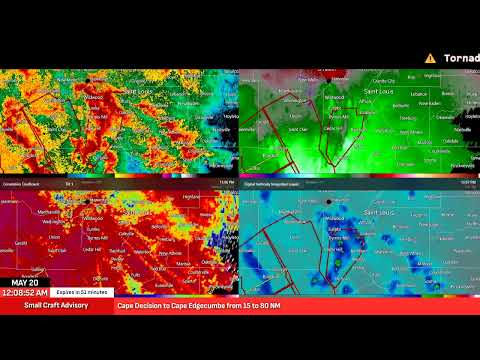Understanding Tornado Warnings: A Comprehensive Guide to Staying Safe
Tornado warnings are crucial for protecting lives and property. This article delves into the multifaceted world of tornado warnings, exploring their significance, how they connect to related events, and their implications for public safety and preparedness. We’ll unravel complexities, address misconceptions, and consider future trends, all while drawing from content focusing on real-world applications and practical solutions.
The Importance and Practical Significance of Tornado Warnings
Tornado warnings play a pivotal role in various sectors, highlighting their tangible value in today’s dynamic environment. They provide critical information enabling individuals and communities to take necessary precautions, minimizing potential harm and destruction. Understanding the real-world application of these warnings is paramount for ensuring safety and resilience in the face of severe weather.
[IMAGE: https://i.ytimg.com/vi/MnhYwnZvlT0/hqdefault.jpg Alt Text: A tornado barreling towards St. Louis during a tornado warning.]
The Synergistic Relationship Between Tornadoes and Outbreaks
The relationship between tornadoes and outbreaks is interconnected. Advances in understanding outbreaks can directly catalyze innovation and development within tornado warning systems. Conversely, progress in tornado detection and prediction can unlock new potentials for understanding and mitigating outbreaks, creating a positive feedback loop. This synergy is essential for improving overall preparedness and response to severe weather events.
Addressing Common Misconceptions About Tornadoes
Many individuals underestimate the depth and complexity of understanding tornadoes. A thorough analysis reveals a more intricate and detailed reality than casual observers might perceive. Debunking these misconceptions is crucial for fostering a more informed and prepared public.
- Misconception: Understanding tornadoes is straightforward.
- Reality: Tornadoes are complex phenomena influenced by numerous factors, requiring in-depth scientific analysis.
The Evolution and Future Trends of Tornado Warnings
Considering future trends, it’s plausible that tornado warning systems will evolve by incorporating elements of emerging technologies like AI and machine learning, especially when considering advancements in related fields. This foresight is often a key discussion point in forward-looking content, and we’ll explore some potential evolutionary paths for tornado warnings in the coming years.
[IMAGE: A conceptual diagram of a future tornado warning system using AI. Alt Text: Future tornado warning system diagram.]
The Methodology Behind Understanding Tornadoes
Understanding or implementing effective tornado warning systems involves a structured approach comprising several key stages:
- Comprehensive preliminary research and meticulous data gathering: Gathering accurate and detailed information is the foundation for effective analysis.
- Rigorous analysis, strategic planning, and hypothesis formulation: Analyzing data and developing strategic plans are crucial for predicting tornado behavior and implementing effective warning systems.
- Iterative implementation, continuous monitoring, and adaptive feedback loops: Continuously monitoring and adapting warning systems based on real-world feedback is essential for improvement.
Exploring the Impact of Events on Tornado Understanding
Exploring the impact of specific historical events can add another layer of understanding to tornado phenomena. This might involve discussions on ethical considerations that arise with new applications or the socio-economic shifts driven by its adoption, showing how interconnected these ideas truly are and what broader effects they might have.
[IMAGE: https://i.ytimg.com/vi/Ix145HEwVSQ/hqdefault.jpg Alt Text: May 19th 2025 Tornado Outbreak.]
Frequently Asked Questions (FAQ)
Q: What is the most critical takeaway regarding tornado warnings?
A: The most critical takeaway is the importance of understanding the real-world applications and practical significance of tornado warnings, enabling individuals and communities to take necessary precautions and minimize potential harm.
Q: How do advances in related fields impact tornado warning systems?
A: Advances in understanding outbreaks and related phenomena can directly catalyze innovation and development within tornado warning systems, creating a positive feedback loop.
Q: What are the key stages involved in understanding and implementing effective tornado warning systems?
A: The key stages include comprehensive research and data gathering, rigorous analysis and planning, and iterative implementation with continuous monitoring and adaptive feedback loops.
Conclusion: Synthesizing Knowledge on Tornado Warnings
In conclusion, understanding tornado warnings involves grasping their practical significance, recognizing the interconnectedness of tornadoes and outbreaks, addressing common misconceptions, and anticipating future technological advancements. By embracing continuous learning, critical thinking, and interdisciplinary collaboration, we can enhance our preparedness and response to these severe weather events. The paramount takeaway is the critical nature of continuous evolution and adaptation regarding tornado warnings, emphasizing the ongoing importance of lifelong learning, critical thinking, and interdisciplinary collaboration in this dynamic field. This proactive approach is essential for creating safer and more resilient communities in the face of increasing weather-related challenges.






